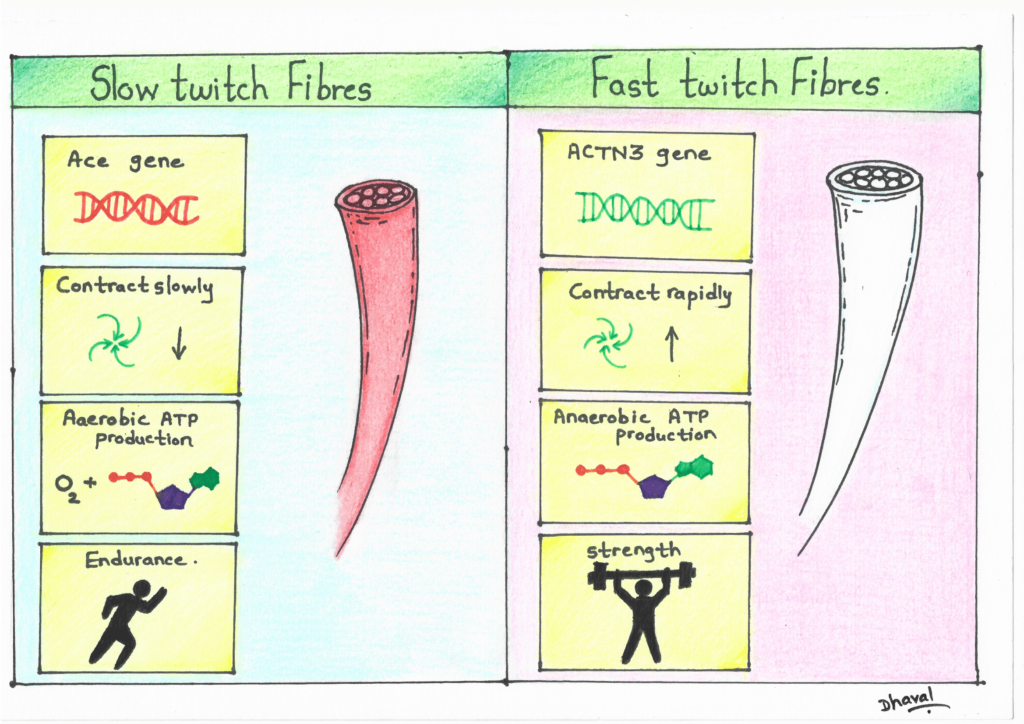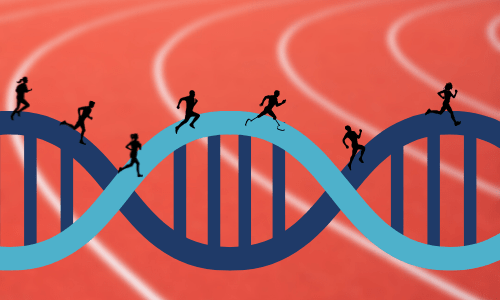We have always questioned what makes Usain Bolt the fastest person on earth? Is it his genes? His talent? Or something else? People like him have achieved unimaginable heights in different realms of sports. Scientists have begun to question if these people are built differently than us. They think that Bolt has a special muscular built that makes him unique.
This makes one wonder, how important is the role of genetics and physiology in our athletic performance?
From a scientific perspective, it could be assumed that “elite athletes” have “elite phenotypes”. But, most often, complex traits cannot be easily explained by genetics. Certain environmental factors can also influence an athlete’s performance. Many genetic factors affect an individual’s physical capabilities, such as the type of muscle fibres and the strength of his muscles. The muscle fibres are of two types, fast-twitch and slow-twitch fibres. Some fibres are undifferentiated, and the type they acquire will depend on how often we use them. Slow-twitch fibres generate energy from oxygen. They contract slowly and can sustain activities for a long time. Since they do not tire easily, they are best suited for long-distance running and other endurance activities. On the other hand, sprinters like Usain Bolt have high amounts of fast-twitch fibres that play a role in their speed. These fibres contract quickly, but they do not use oxygen to generate energy. Thus, they tire easily and are useful for activities that require strength or power.

Some genes like ACE and ACTN3 have been associated with athletic performance. These genes influence the type of muscle fibres. They also influence endurance and strength. For example, ACTN3 codes for a protein alpha-actinin-3 which makes up the fast-twitch fibres. Variations in this gene can alter the amounts of fast-twitch fibres in an individual’s muscles. Thus, affecting his performance. One such variant called R577X lacks both functional copies of this gene. Such individuals have reduced fast-twitch and increased slow-twitch muscle fibres in their bodies.
However, establishing a correlation between genetics and an athlete’s performance is complicated. This is because each sport has its own physical requirements. Such requirements vary from one sport to another. Some sports value strength, others value endurance. Thus, it is crucial to consider components of an athlete’s performance essential for a particular sport as athletes have different bodies according to the type of sport they partake in.
Apart from genetics, the role of physiology in influencing an athlete’s performance also needs to be explored. Sports physiology has become a domain in itself. It involves studying the effect of exercise or training on the anatomical structure and the physiological function of the body. Our body’s structures and functions change when we exercise. This involves changes in our skeletal muscles’ ion concentrations, temperature, and acidity, affecting our athletic performance. The body’s physiological response to training or exercises is also influenced by the type of exercise along with its frequency, duration, and intensity. For instance, there is an increase in muscle size in strength training because of the increased production of contractile proteins. Likewise, endurance exercises lead to an increase in enzyme concentrations in the skeletal muscles.
Coaches and trainers often use special tests to assess an athlete’s performance. The information derived from these can be used to train our bodies better and improve our performance. It is believed that training can significantly change the muscles’ physiology, thereby improving athlete performance. Most sprinters benefit from abundant fast-twitch fibres, which help them gain speed and produce power and force. Sprinters like Bolt also have large anaerobic capacity. This energy source is used at the start of any intensive exercise but depletes quickly. A combination of a high proportion of fast-twitch fibres with large anaerobic capacity allows Bolt and other sprinters to produce a fast push with every step they take.
We may think that the right kind of training will help us modify our physiology and become sprinters like Bolt quickly. But this could not be farther from the truth. Most scientists believe that the natural built of an athlete plays a more important role in influencing his performance. However, the role of exercise and training in improving an athlete’s physiology and performance is irreplaceable and cannot be undermined.
References
- Guth, L. M., & Roth, S. M. (2013). Genetic influence on athletic performance. Current opinion in pediatrics, 25(6), 653–658. https://doi.org/10.1097/MOP.0b013e3283659087
- Ahmetov II, Egorova ES, Gabdrakhmanova LJ, Fedotovskaya ON. Genes and Athletic Performance: An Update. Med Sport Sci. 2016;61:41-54. doi: 10.1159/000445240. Epub 2016 Jun 10. Review. PubMed: 27287076.
- https://www.physio-pedia.com/Physiology_In_Sport
- https://www.run3d.co.uk/news/how-does-usain-bolt-run-so-fast
Writer

Urvi Agarwal
Urvi is a biotechnology graduate. Her love for biology and writing motivated her to share interesting science stories. Currently, she is pursuing her interest in writing as a freelancer. In the future, she would like to make a career in scientific research and also continue to communicate science.
Illustrator

Dhaval Shejwal
Dhaval is currently pursuing his bachelors in Microbiology. Both science and art are his passions. Creativity keeps him going. Scientific data visualization and communication have become the need of time and necessity, as well to break the wall between a lab and home. According to him, “Art is a beautiful reflection of Science, there is art in science and science in art”.

